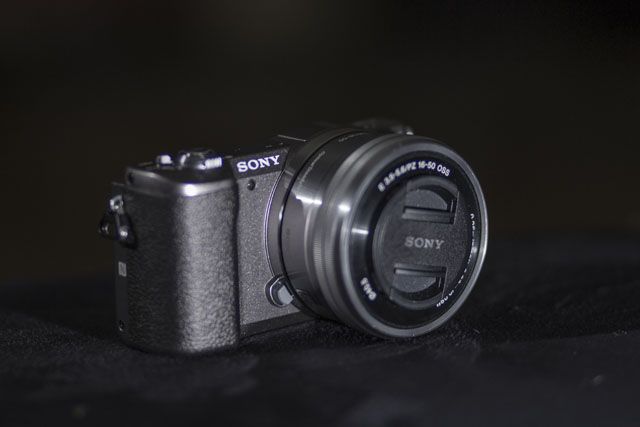Sony a5100 Mirrorless Camera
The $500 Sony a5100 is the entry level camera in Sony's Alpha line. It has a 24 megapixel APS-C CMOS sensor — the same style of sensor found in entry level DSLRs. I reviewed the a5100 with the 16–50mm f/3.5–5.6 kit lens; and at the end of this review, we're giving it away to one lucky reader!
As I talked about in my review of the similarly priced Olympus OM-D E-M10, mirrorless cameras are beginning to successfully compete with entry level DSLRs. While the Olympus used a slightly smaller sensor, the APS-C one in the a5100 is identical in size to those in entry level DSLRs from the likes of Canon and Nikon. This, theoretically, means that the image quality should be roughly on par (something I found held true with the Olympus) despite their significantly smaller form factor.
Like any good camera, the a5100 shoots RAW files, has manual exposure controls and access to a wide range of interchangeable lenses. This means, that if it's good, it could be a true contender with entry level DSLRs. We decided to find out.
The Image Quality
Just as with the Olympus, the most important thing the a5100 had to deliver on was image quality. If it fell short here, the rest of the review would be irrelevant. Unless the a5100 could compete with an entry level DSLR it was dead on arrival. That isn't the case.
The RAW files from the a5100's 24 megapixel APS-C sensor are excellent. Once again I used my three year old Canon 650D (which was $1400 new) as a rough baseline for DSLR quality. There was very little in the difference. As with all RAW files, they tend to be quite flat out of camera but a few tweaks in Lightroom is enough to bring out the best in them. If you're planning to shoot with the a5100 you should plan to do the same.
There was plenty of data in a properly exposed RAW file. Even in an under- or overexposed file I was able to recover a lot of detail from the shadows and highlights. This is why you should be shooting RAW.
Even at ISO 1600, which I consider to be the base for low light photography, the a5100 was producing relatively clean images. The further I pushed the ISO the more noise that crept in, but at working ISOs it was never too much of an issue.
Shooting with the a5100
Mirrorless cameras have the advantage of being much smaller and lighter than any DSLR, however, this means compromises must be made elsewhere.
While the Olympus had an electronic viewfinder, the a5100 only has the 3" LCD screen on the back. This means shooting with it is a significant departure from shooting with a DSLR. Even after a few hours use, I still kept trying to hold hold the a5100 up to my eye rather than out at arms reach. If you're transitioning from a smartphone this will be entirely natural to you, however, if like me you're more used to shooting with a DSLR this will take some adjustment.
Using the LCD screen has other disadvantages. It's fine most of the time but in bright sunlight it can be hard to see the finer details on your subject. The screen is reflective so there's some glare. Unlike some mirrorless cameras, there's no way to add an electronic viewfinder. You're stuck with the screen on the back. If this is a deal breaker for you, you might be better with the next model up in Sony's line, the a6000, or the Olympus E-M10.
Aside from being the only viewfinder, the 922k dot touch screen is good. Pictures look bright and sharp when you review them. The touch screen is fast and responsive. It even tilts fully up to a vertical position so you can take selfies.
The physical controls is another area where the a5100 falls short of the E-M10. There's a single dial on the back that has a built in four-way controller. Almost everything is managed through it. While this keeps everything accessible, it means changing anything normally requires one or two presses. This isn't unmanageable, but does slow down shooting.
The a5100's autofocus is rock solid. It rarely missed focus while I was using it. With 179 focus points, it's got great coverage of the whole image area so even if your subject is off centre from the frame it should have no issue locking focus. It's fast, finding focus quickly in most situations.
The Ecosystem
Sony's mirrorless ecosystem is probably the strongest around. There are more than 40 lenses available with the E-mount the a5100 takes. Whatever you're looking to shoot, there will be a lens that does the job. They have fast primes for portraits and long zooms for sports or wildlife photographers.
While all the lenses are great, what really makes Sony's ecosystem shine is the other cameras in the line up. The a7 series are the most popular full frame, mirrorless cameras among professionals. While they cost significantly more than the a5100, they use most of the same lenses. This means that you can start with the cheaper a5100, invest in a few lenses and, as long as you're careful with your choices, they will work with any other mirrorless camera in Sony's line.
Unlike other mirrorless lines, you can invest in Sony Alpha gear and know that it will grow with you as a photographer. For me, this is the biggest selling point of the a5100. I still use the first lenses I bought for my Canon 650D with my 5DIII. You can do the same with Sony.
The Kit Lens
The 16–50mm f/3.5–5.6 kit lens that came with my review model is a fine lens. While it has no major strengths, it has no big flaws either. The 16–50mm focal range is broad enough for everyday use. There's enough width for group shots or landscapes, and enough zoom to take portraits. The f/3.5–5.6 aperture range is standard on entry level zooms so I can't really criticise it.
As with the Olympus, the lens is a lot larger when the camera is turned on. However, it's size when off is still about an inch and a half. It doesn't pack down to the same small size. With the lens attached, you can't stick the a5100 in any pocket and go.
The Build Quality
The a5100 has an all plastic body. One of my favorite things about the E-M10 was it's metal construction, however, that was incredibly unusual. Most cameras the a5100 is competing against, like Canon and Nikon's entry level models, are all plastic construction as well.
As an all plastic body, it has no weatherproofing. Yes, it'll survive a few splashes but if it gets too wet it will break.
One thing that annoyed me about the build was the positioning of the neck strap lugs. One is attached directly on the handgrip. When you're holding the a5100 you're holding the lug as well. This is more of annoyance than a genuine problem but it does make your grip feel a lot less secure.
The Extra Features
Like the E-M10, the a5100 comes with extra features with varying levels of usefulness.
The a5100 can shoot 1080p video at 60fps however the lack of an external microphone port means that audio quality will always be an issue. There's deeper controls for video than are available with the E-M10 so if video is important to you, the a5100 is a better buy.
There's Wi-Fi for sharing images to your phone. However, most apps won't handle RAW files which you should be shooting.
The strangest extra feature, and one that tells you who this camera is aimed at, is the Help button on the back. The a5100's help menu provides information on everything from using the camera to taking portraits. If you're starting out it's not the worst source of information I've ever seen, however it doesn't compare to reading a book on photography. It's a nice fall back if you need a refresher but still seems a strange feature to me.
What's Not to Like?
There's a lot to like about the a5100 and very little in the way of deal breaking issues. Although I've criticised things like the lack of an EVF, these aren't standard on mirrorless cameras in it's price range. Similarly, the controls are only slightly worse than what you find on much larger entry level DSLRs. These are issues you'll encounter with almost every other competing camera.
Although the Olympus E-M10 I reviewed previously is a slightly better camera, if you're interested in video or investing in an ecosystem that will last you for years the a5100 is a better buy. I won't be trading in my DSLR in a hurry, but there is a lot to be said for getting into a mirrorless ecosystem now if you're just starting out.
[recommend]The a5100 is a great beginners mirrorless camera with an ecosystem you can grow into.[/recommend]
Sony a51000 Mirrorless Camera Giveaway
Send your products to be reviewed. Contact James Bruce for further details.








